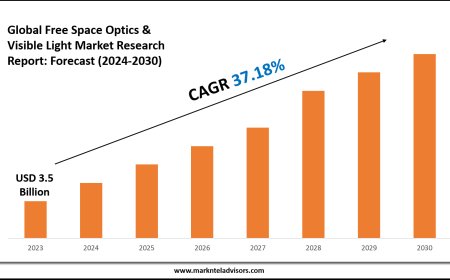Helium-3 Market Set to Expand with Rising Demand for Rare Isotopes
The global helium 3 market size was valued at USD 178.68 million in 2023 and is projected to reach USD 224.59 million by 2031, with a CAGR of 2.9% during the forecast period of 2024 to 2031.
Introduction
Helium-3 (He) is a rare, non-radioactive isotope of helium that has unique nuclear and physical properties. Unlike the more common helium-4, helium-3 has exceptional potential for use in cryogenics, neutron detection, fusion energy research, and medical imaging. Due to its scarcity and high strategic value, thehelium-3 marketis niche yet poised for significant growth as scientific and defense communities invest in advanced technologies.
The demand for helium-3 is primarily driven by government programs, research institutions, and high-tech industries. Despite its limited supply, technological advancements and renewed interest in clean energy and security applications are reshaping the outlook of this specialized market.
What Is Helium-3?
Helium-3 is a light, stable isotope consisting of two protons and one neutron. It is not abundant on Earth but can be produced as a byproduct of tritium decay or extracted in minute quantities from natural gas reserves. Helium-3's rare nuclear properties make it especially useful for:
-
Neutron detectionin security and nuclear safeguards
-
Cryogenics, particularly in cooling superconducting magnets
-
Nuclear fusionresearch, as a possible clean energy source
-
Medical imaging, such as MRI contrast agents for lung imaging
-
Quantum computing and low-temperature physics
Key Market Drivers
1. Nuclear Security and Border Protection
Helium-3 is vital for neutron detection in homeland security. It is used in portal monitors and radiation detectors at ports, airports, and border crossings to prevent the illicit transport of nuclear materials.
2. Fusion Energy Research
Helium-3 is considered a potential fuel for nuclear fusion reactors, particularly in aneutronic fusion, which offers a cleaner alternative to current fusion methods. As investment in fusion power accelerates, so does interest in helium-3.
3. Cryogenics and Superconductivity
Helium-3 is used in dilution refrigerators and ultra-low-temperature systems. These are critical for quantum computing research, superconducting technologies, and experiments in fundamental physics.
4. Medical Imaging
Though still in experimental stages, helium-3 can be used as a contrast agent in MRI, offering superior imaging of the lungs and airways. It presents an opportunity in the medical imaging field, especially in respiratory diagnostics.
5. Scientific and Academic Research
Institutes around the world require helium-3 for fundamental research in particle physics, magnetism, and cosmology. Despite limited access, helium-3 remains indispensable in various low-temperature experiments.
Market Constraints
-
Extremely Limited Supply: Helium-3 is rare and expensive. Most of the global supply is sourced from the decay of tritium, which is itself a controlled material.
-
Regulatory Barriers: Due to its potential nuclear applications, helium-3 is subject to strict regulation and export controls. Access is largely restricted to government and research entities.
-
High Production Costs: Producing helium-3 from tritium decay is a slow and costly process. Alternatives such as lunar extraction remain theoretical at this stage.
-
Lack of Commercial Infrastructure: The market is largely government-driven. Private sector participation is minimal, limiting commercialization and innovation.
Supply Sources
The majority of the helium-3 supply has traditionally come from the decay of tritium stockpiled for nuclear weapons. With global disarmament programs reducing tritium production, the helium-3 supply has dwindled.
Other emerging sources and future possibilities include:
-
Nuclear reactorsthat produce tritium for controlled decay
-
Reprocessing of retired nuclear warheads
-
Potential lunar mining, as helium-3 is believed to exist in larger quantities in the Moon's regolith
-
Production from fusion reactors, if commercialized
Market Segmentation
By Application
-
Homeland Security and Defense
-
Cryogenics and Low-Temperature Physics
-
Energy and Fusion Research
-
Medical and Healthcare
-
Academic and Industrial Research
By End User
-
Government Agencies
-
Research Institutes
-
Medical Institutions
-
Defense Organizations
-
Energy Sector Innovators
Regional Outlook
North America
The United States is the leading consumer and distributor of helium-3, primarily through government programs such as the Department of Energy (DOE) and Department of Homeland Security. With significant funding for fusion and national security, the U.S. dominates the global market.
Europe
European nations are increasing investments in nuclear research and quantum technologies, which depend on helium-3. The European Organization for Nuclear Research (CERN) and other institutions contribute to demand.
Asia-Pacific
Countries like China, Japan, and South Korea are investing in fusion energy and quantum computing. While local production is minimal, demand is growing in research and technology sectors.
Rest of the World
Access to helium-3 in Latin America, Africa, and the Middle East is limited. However, international collaborations and defense partnerships occasionally facilitate supply in emerging markets.
Competitive Landscape
Given the controlled nature of the helium-3 market, only a few players manage its distribution. These include:
-
Government organizations: U.S. Department of Energy, Atomic Energy of Canada Limited
-
Defense contractorsand specialized suppliers that manage isotopic materials
-
Research labs and public institutionsinvolved in procurement and utilization
Emerging private companies and fusion startups may begin to influence supply dynamics as the market becomes more innovation-driven.
Future Outlook
Thehelium-3 marketis poised for moderate but strategic growth. While the commercial market is small due to limited availability and high costs, its role in high-value sectors like nuclear security, fusion energy, and quantum technologies ensures it remains vital.
As investments in clean energy, advanced computing, and medical imaging continue to grow, so too will the importance of helium-3. Breakthroughs in production methodssuch as lunar extraction or synthetic generationcould revolutionize supply dynamics in the coming decades.
Governments and research institutions will likely remain the primary market drivers, but increased collaboration with private sector innovators could gradually expand the markets commercial footprint.
https://chincholkarpooja.blogspot.com/2025/07/textile-chemicals-market-cagr-of-52.html
https://chincholkarpooja.blogspot.com/2025/07/varicose-vein-treatment-market-cagr-of.html
https://chincholkarpooja.blogspot.com/2025/07/wearable-devices-market-cagr-of-187.html
https://chincholkarpooja.blogspot.com/2025/07/middle-east-and-africa-processed-meat.html
https://chincholkarpooja.blogspot.com/2025/07/north-america-hummus-market-cagr-of-81.html
https://chincholkarpooja.blogspot.com/2025/07/north-america-hummus-market-cagr-of-81.html
https://chincholkarpooja.blogspot.com/2025/07/business-process-outsourcing-bpo-market.html
https://chincholkarpooja.blogspot.com/2025/07/healthy-snacks-market-to-reach-usd.html
https://chincholkarpooja.blogspot.com/2025/07/manufacturing-execution-system-mes.html
https://chincholkarpooja.blogspot.com/2025/07/india-business-process-outsourcing-bpo.html





































